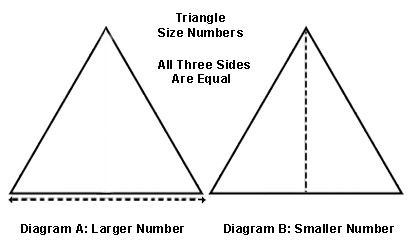|
Click on any origami item shown in the image below for a bigger image and more info.


Side View 

|
 |
*Note that two numbers are given for the size of this item.
The larger number is the measurement along any one of the three sides of the triangle.
(Diagram A)
The smaller number is the measurement from the point at any corner to the center of the opposite side. (Diagram B)
|
If you like the above, you may also like:
|
| Set ID #: | 6094 |
| Category: | Non-Modular -- Very Small Triangular |
| Lid Size*: |
7.5 cm (3 in) and
6.5 cm (2.6 in)
|
| Base Size*: |
5 cm (2 in) and
4.3 cm (1.7 in)
|
| Box Height: |
2.6 cm (1 in)
|
| Style: | Non-Modular Self-Closing Triangle - Truncated Tetrahedron |
| Designer: | Arnold Tubis |
| Design Source: | Box: Free diagrams (PDF) on OrigamiUSA Site
From The Fold: Issue 76, May-June, 2023 >> Click here
Hexagon Sheet: Free diagrams (PDF) on OrigamiUSA Site
From The Fold: Issue 78, Sept-Oct, 2023 >> Click here
|
| Paper Type: |
PapierDesign Double-Sided Origami Paper: Kaleidoscope Duo Spring Golden; Kaleidoscope Duo Autumn; Kaleidoscope Duo Happiness
Tuttle Publishing Double-Sided Origami Folding Papers - Kimono Patterns - Jumbo Pack
|
| Sheet Size: | 21 x 18 cm (8.3 x 7.1 in) Hexagon
Cut from a 21 cm (8.3 in) Square Sheet |
| Sheets Used: | 1 |
| Paper Source: |
OrigamiUSA
Amazon
|
| Comments: | These self-closing triangular boxes do not have a separate lid and base. The whole structure of each box is formed from a single hexagonal sheet of paper.
I used a purchased template to cut my hexagon, but I have provided a link above to some diagrams which show an origami fold-and-cut method for getting a regular hexagon from a square.
Although double-sided paper was used here, this style of box could readily be made from single-sided paper, since none of the reverse side of the paper shows in the finished model.
The opening/closing mechanism is not complex. When closing this style of box, three flaps are tucked in so that they overlap each other. Opening the box involves gently untucking these flaps.
Although this model looks pretty simple, it is actually rather challenging to fold. Extensive, precise pre-creasing is required and the steps which take the model from 2-dimensional to 3-dimensional are rather tricky.
Arnold Tubis has written that this model was inspired by the works of the late Philip Shen, and that Steps 5 through 12 "describe a signature Shen folding maneuver." I have not yet worked on any Philip Shen models, but now I am curious to try some. |
| |
|
Click here to see more Self-Closing Non-Modular Triangles
|
|



